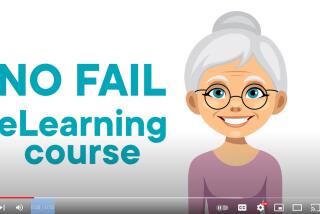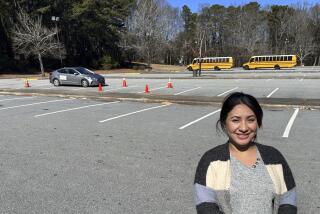Driver Reeducation : High-Tech Cars Call for High-Tech Pilots
Ford Motor Co. in broad, extravagant promotion of its new Turbo Thunderbird, chauffeured 305 Southern California disc jockeys to Riverside International Raceway last week.
There--chaperoned by drivers from the British School of Motor Racing--the broadcasters drove 26 showroom Thunderbirds for a combined total of 1,200 laps and 3,000 miles at not much more than freeway pace.
The cars performed to the best of their high technology.
The DJs, in the main, weren’t as poised. They ground gears and missed shifts. Several ran off the track. One drove the 2.5-mile circuit in third gear. A few balked at driving a car with a stick shift. One said he didn’t know how.
It was classic illustration of a concern being expressed by a corps of driving instructors, professional drivers and automotive safety experts: That today’s nimble, sophisticated automobiles clearly are beyond the abilities of their ham-handed owners.
Science of Car Control
“We have a situation where 92% of American motorists are negotiators because nobody taught them any differently,” Bob Bondurant of Sonoma said. He is a retired Formula One race driver who preaches high performance driving as the science of car control, not the senseless application of speed. “Only 5% of todays’ motorists drive well. Less than 3% drive a lot better than well.”
Terry Earwood, a professional stock car racer and driving instructor with a nationwide student body, including high school teen-agers and state troopers, agreed: “The average driver’s learning process begins with high school driver ed and ends with the first 5,000 miles of experience. At least 70% of all motorists drive a car at only 50% of its potential.”
Yet on asphalt campuses throughout the state, Bondurant and Earwood and other teachers are working to change that situation and the statistics.
So are their students, ordinary Californians paying to become polished, extraordinary motorists capable of handling by evading all the daily dramas and periodic high emergencies of interstate, freeway and surface streets.
They are learning to accelerate out of traffic clutters that threaten trouble, not brake into them. Skids are no longer their peril. Alert lane changes, just enough brake, exactly the right amount of throttle with a reflexive touch of steering has become their accident-avoidance system.
From San Diego to Sonoma, from Riverside to Lancaster, they are registering for performance driving courses that are, in a phrase, adult driver reeducation.
Decades of bad habits are being broken at one-day schools (price: from $325 to $400) where teachers, cops, homemakers and driving instructors of more sedate methods are slinging expensive cars (yours or the school’s) around greasy or water-soaked skid pads.
Learning Proper Technique
A two- or three-day session ($700-$975) typically involves correct cornering and braking techniques around the country road curves of a race track, possibly the same circuit once driven by a Mario Andretti or a Danny Sullivan.
For those who want it all (such as James Garner, who did his own stunts in television’s “The Rockford Files,” and Gene Hackman who did likewise in “The French Connection”), there’s a four-day $1,995 course in Northern California that elevates individual driving skills from street driving to the entry level of amateur sports car racing.
Even dealers and manufacturers--from BMW to Maserati to Porsche--are offering retraining for freeway masses awakening to the realization that basic skills learned on an overweight, ill-cornering Chevrolet of the ‘60s are below par when it comes to driving a quick Maserati Biturbo of the ‘80s.
A Los Angeles woman fresh from a one-car spinout on the Harbor Freeway has enrolled. So have L.A. lawyers and a wholesale stationery supplier from Van Nuys. They are signing up for classes at:
-- Any of three high-performance street driving schools currently operating at remote Willow Springs Raceway at Rosamond, west of Edwards Air Force Base.
BMW of North America--in conjunction with the nationwide Skip Barber Racing School of Canaan, Conn., and with Earwood as a senior instructor--is offering courses at the track. The factory supplies the cars ($35,000 BMW 535s) because, said a spokesman, “people get closer to their limits when the wear is on somebody else’s tires.”
The Drivers’ Connection--using Toyota Celicas driven during the annual Pro-Celebrity race at the Toyota Grand Prix of Long Beach--operates a variety of “vehicle control” courses at Willow Springs. So does Connie’s Team, a school that last year held 16 advanced driving classes under the supervision of Connie Fern of Mar Vista. She races a Porsche 911 at Sports Car Club of America meets.
“The larger percentage of my students, more than 70%, aren’t interested in racing and just want to learn to handle their cars better and to be safer drivers,” Fern said.
-- Wilshire Maserati of Beverly Hills, which offers free driving courses to its customers. General manager Murray Marks supplies two lightly prepared (stiffened suspension, tougher brakes, four-point seat belts) Maserati Biturbos as teaching aids and rents Riverside Raceway for the day.
Car Dealers Start Programs
-- Several Porsche dealerships that have started their own programs. Although Porsche of North America does not sponsor advanced driver training, “It is something we’re looking at,” a representative said. Last year, Alan Johnson Porsche Audi Inc. of San Diego graduated 65 customers from a series of two-day ($50) sessions held in the parking lot at Jack Murphy Stadium.
-- The Bondurant School of High Performance Driving at Sears Point Raceway near Sonoma, which graduated actors Garner and Hackman. In business for 20 years, the school pioneered terrorist avoidance techniques for corporate and diplomatic chauffeur-bodyguards.
Last year, Pacific Gas and Electric put drivers from its Golden Gate region through the school’s one-day course. Now Bob Bondurant--owner, founder and president of the school--is ready to take his show on the road, offering one-day schooling to Ford customers nationwide. A prototype course, fully supported by Ford, will be staged in San Diego in April.
Distribution starts this month of a 60-minute home video by three-time world driving champion Jackie Stewart. It is aimed at doing for drivers what Jack Nicklaus’ tape has done for golfers.
Stewart says his concern is rooted in National Safety Council statistics showing that “every road user will be faced in 20 years of driving with two serious, life-threatening situations.
“It would be nice to know a couple of things,” he said, “such as things you learn on a skid pad--for when they happen.”
“Most drivers react to a crisis by heading straight for the trouble with their brakes locked up while they holler: ‘Oh, God, please don’t let me hit it.’ That is not what we consider an effective accident-avoidance technique.”
That’s a typical, valued, oft-repeated and almost collectible Earwoodism. He’s full of them, this good old Georgia boy, a cocky bantam who walks, talks and might even sleep on the balls of his feet.
“I said ‘car’ before I said ‘mother,’ ” he said.
“Inherent in the American male child is the desire to keep his right foot planted firmly on the accelerator during a skid. . . .”
This is Earwood’s way. He knows he’s teaching grown men to drive and that their egos will resist. So he hammers the points with humor. He seduces novices to his expert level.
Earwood, 40, has been a performance driving instructor for years. He developed a police pursuit training program for the Georgia State Patrol. Now he teaches the BMW program.
He recognizes the enormous gap existing between motorists and their vehicles. Cars improve annually, Earwood said, drivers do not. He well remembers his early cars: “Twenty-two years ago I had a ’64 (Pontiac) GTO that was faster than the word of God. But it wouldn’t stop in a 40-acre field.
“Today’s cars are much, much better in terms of total response. High-performance cars of yesterday were just a motor. High-performance cars of today have better brakes, better handling and you don’t beat yourself to death in the process. We have the same zero-to-60 (miles-per-hour) times as before . . . but from 60 to zero the new cars are a whole new breed.
“Now you have throttle response so you can get out onto the interstate much better, smoother and with haste. You can brake efficiently and go through corners without having to take Dramamine. Today’s cars are the whole package and that’s what I mean by high performance. I’d like to take the speed away from any references to high performance.”
That is the rigid doctrine, the practice and the preaching at all advanced driving schools. There is neither skill nor bravery, states Earwood, in going fast in a straight line. Just speed, Bondurant insists, is bad driving. “Good driving,” he said, “is precision, smoothness, accuracy.”
During the past 18 months, Earwood has polished 1,000 drivers at the BMW school. At Willow Springs, his classroom is a 400x400-foot patch of asphalt divided into a skid pad and slalom course.
The pad is a circle soaked by a water truck for maximum slickness. The slalom is a Malibu Grand Prix for big boys.
On the pad, in the wet, by degrees, Earwood’s drivers create then cavort through a repertoire of skids. The students--remembering everything dad taught them--steer into the skid.
Surprise. They’ve only handled half of the emergency. The second half arrives after skid correction, sudden peace and a pause. Then the tail of the car whips savagely the other way.
Staying on Top of It
“That pause is the eye of the hurricane,” Earwood said. “All that energy pushed into the suspension during the skid has to go somewhere. So when you correct, energy transfers to the other side and if you’re not on top of it, you start skidding the other way.
“Steer into the skid. Catch the whip. Drive on if the road is clear. If it isn’t, lock the steering up as hard as you can, do a Danny Sullivan and spin the car out.”
Oh, sure.
“Oh, yes,” Earwood said. “What we see on the skid pad is a gross number of students who, the first three times they enter a skid, just give me 30% or 40% of the car’s steering capacity and say: ‘If I do any more, the car will turn over and burst into flames.’
“When they say that, I reach over and take the wheel and show how much the student wasn’t using. Which is the 60% that allows you and the car to get out of the situation.”
Emergency lane changes are taught at the school. Correct seating position. Threshold braking that doesn’t lock up the wheels. Steering by feeding the wheel through the hands--with smoothness, precision and accuracy.
“We show people more in one day than they have learned in their entire driving careers . . . to feel the car through the seat of the pants, to romance the brake, to feather the throttle, to learn panic braking, skids and lines and trail braking.
“We advance a driver to the better characteristics of his car. He learns he’s driving a package, not just a steering wheel and a pedal and a stereo system.
“And that isn’t just for men. Women have all the equipment for being better drivers than men. But society never allowed them to have a love affair with the car. They rode in it. They weren’t allowed to drive it.
“Yet women have a lot of touch for the car.” He couldn’t resist one more Earwoodism. “They don’t, for want of a better word, manhandle a car.”
But can new motoring tricks stick to old driving dogs?
There have been no formal studies of the efficacy of advanced driver education. The practice is too new, say representatives of the National Safety Council and the National Highway Traffic Safety Administration.
But, they agree, if high-performance courses are geared to safety and not speed, then benefits must be presumed.
Earwood offers informal proof. “In the first 12 months of teaching the Georgia State Patrol there were savings to the state of $184,000,” he said, noting that less sheet metal was bent and fewer man hours were lost. There are also, of course, the testimonials of the graduates.
Carla Hodkinson, a Los Angeles immigration attorney, said she once was “a rather timid driver.” Then she bought a Toyota MR2, a mid-engined sports car capable of 120 mph. “I had to ask myself: ‘Will I ever be able to drive it the way it should be driven?’
“I wanted to get a sense of what the car could do and what I was capable of . . . to see if I could progress through being a timid driver.”
So she went to Willow Springs and joined Connie’s Team.
Doubled Her Ability
“I estimate that I was driving between 30% and 40% of my ability when I got there, and improved to 70% or 80% by the end of the course. This kind of training puts the vehicle within your control, not beyond your control.”
Peter Desalay is 38, owns a stationary supply company in Van Nuys, drives a Mercedes and a Porsche 928, and at one time considered himself “a hotshot, a very aggressive driver frustrated by the flaws of bad drivers.”
Then he purchased a Maserati Biturbo and with it came a letter from Murray Marks: “To show our appreciation, we would like to welcome you on board for a one-day driving course at Riverside Raceway.”
Desalay put on a racing helmet, climbed into a flameproof driving suit and spent a day slaving over hot turns.
“Now I know how to corner without fishtailing, how to brake without locking up the wheels, how to switch lanes in a panic situation.
“I feel more security, I feel more confidence. I intend to come back and do the three-day course. Not to race, but just for the enjoyment of doing something well.”






